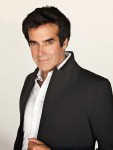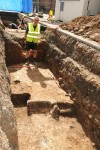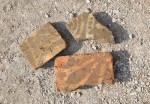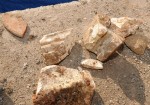Great news on two King fronts. First, the interview with Dr. Martin Luther King Jr. discovered in a Nashville attic has been bought by magician David Copperfield. This is great news because he’s donating it to the National Civil Rights Museum in Memphis, the museum located in the Lorraine Motel, the place where Martin Luther King was assassinated.
 Copperfield enjoys collecting historical objects, particularly magic ones (remember the 1906 verbal gypsy fortune teller?), and even though Dr. King never made the Statue of Liberty disappear, as a dream merchant David has been inspired by the man who so famously expressed his own dream of equality and freedom with world-shifting results. He was particularly moved by the intimate, conversational tone of the recording, since so much of what we hear of Martin Luther King Jr. are speeches and sermons.
Copperfield enjoys collecting historical objects, particularly magic ones (remember the 1906 verbal gypsy fortune teller?), and even though Dr. King never made the Statue of Liberty disappear, as a dream merchant David has been inspired by the man who so famously expressed his own dream of equality and freedom with world-shifting results. He was particularly moved by the intimate, conversational tone of the recording, since so much of what we hear of Martin Luther King Jr. are speeches and sermons.
Copperfield didn’t want the recording to fall into a private collection never to be heard again, so he bought it himself and picked the National Civil Rights Museum because it’s in Tennessee, the same state where the interview was held and the recording found. The estimated monetary value of the recording was $100,000, but the price Copperfield paid has not been disclosed.
Barbara Andrews, Director of Education and Interpretation at the National Civil Rights Museum, said the museum plans to integrate the recording into the exhibit in the motel room where King stayed the last nights of his life. Few museums have audio from Dr. King integrated into their displays — probably because the King Center has the lion’s share of that material — so this will be a rare and important addition to their collection.
Andrews also said this:
The donation of this recording to the museum offers the opportunity to hear from this civil rights giant one more time – almost as though we are able to connect with him in the present again. At the time of this recording, the world and the movement were at a crossroads: the teeming war in Vietnam helped to shape the evolving foci of Dr. King’s work. On the one hand his attention was turned to the matter of economic justice and eradicating poverty while simultaneously pressing to move America’s moral compass toward human rights and away from the war effort on the other.
 Unless it’s a bald misquote, I’m afraid this statement is just plain false. The interview was recorded on December 21, 1960. At that time, the end of the Eisenhower administration, there were fewer than a thousand US military personnel in Vietnam. It was a year after that before the first American soldier died in Vietnam. Kennedy increased the number of covert troops to 16,000 by the time of his assassination in November of 1963, but real ground troop escalation started under Johnson in August of 1964 after the Gulf of Tonkin Resolution granted him carte blanche for combat operations in Vietnam. The first anti-war demonstration took place in San Francisco in December 1964.
Unless it’s a bald misquote, I’m afraid this statement is just plain false. The interview was recorded on December 21, 1960. At that time, the end of the Eisenhower administration, there were fewer than a thousand US military personnel in Vietnam. It was a year after that before the first American soldier died in Vietnam. Kennedy increased the number of covert troops to 16,000 by the time of his assassination in November of 1963, but real ground troop escalation started under Johnson in August of 1964 after the Gulf of Tonkin Resolution granted him carte blanche for combat operations in Vietnam. The first anti-war demonstration took place in San Francisco in December 1964.
Martin Luther King Jr. was working with Johnson on the Civil Rights Act and the Voting Rights Act in 1964 and 1965, so he was reluctant to voice full-throated opposition to Vietnam. His first public statements against the war came in March 1965, and they were attenuated. He expressed dismay that “millions of dollars can be spent every day to hold troops in South Viet Nam and our country cannot protect the rights of Negroes in Selma,” but he made a point of expressing sympathy for the president’s predicament and supporting Johnson’s call for a diplomatic solution. He first detailed his opposition to the war in specific terms in his Transformed Nonconformist sermon at the Ebenezer Baptist Church on January 16, 1966 (see page 6 for his indictment of the war).
I will spare you the artless segue about kings and war and instead just abruptly switch tracks to Richard III. The excavations under the Leicester parking lot have already born significant fruit. They’ve found the remains of the Church of the Grey Friars.
 When last we saw our heroes from the University of Leicester excavation team, they weren’t even certain they had the right location. Various places had been suggested in the years since development obscured the ruins of the church, and there was a good chance that any identifiable remains could have been destroyed by later construction. As soon as the first two trenches were dug, it was clear the worst case scenario was not going to materialize.
When last we saw our heroes from the University of Leicester excavation team, they weren’t even certain they had the right location. Various places had been suggested in the years since development obscured the ruins of the church, and there was a good chance that any identifiable remains could have been destroyed by later construction. As soon as the first two trenches were dug, it was clear the worst case scenario was not going to materialize.
 The trenches revealed tiled floors at right angles to each other, one a north-south passageway six and a half feet wide, the other an east-west structure sixteen feet wide. North of the east-west floor they found an open space and then a wall five feet thick. The floor tiles are medieval. Archaeologists think the north-south passageway and the intersecting floor were part of the cloister, a square covered walkway around a peristyle garden characteristic of many monastic communities. Cloisters were often built against the warm south side of a church, so that thick wall may be the south wall of the Greyfriars church.
The trenches revealed tiled floors at right angles to each other, one a north-south passageway six and a half feet wide, the other an east-west structure sixteen feet wide. North of the east-west floor they found an open space and then a wall five feet thick. The floor tiles are medieval. Archaeologists think the north-south passageway and the intersecting floor were part of the cloister, a square covered walkway around a peristyle garden characteristic of many monastic communities. Cloisters were often built against the warm south side of a church, so that thick wall may be the south wall of the Greyfriars church.
 On Saturday, the team dug a third trench in the parking lot next door to see if that wall extended eastward, and it does! They found a continuation of the wall, a second wall about 25 feet north and a mortar floor between them. The floor was probably originally tiled as well, but those tiles have been lost.
On Saturday, the team dug a third trench in the parking lot next door to see if that wall extended eastward, and it does! They found a continuation of the wall, a second wall about 25 feet north and a mortar floor between them. The floor was probably originally tiled as well, but those tiles have been lost.
Dig leader Richard Buckley enthuses:
“The size of the walls, the orientation of the building, its position and the presence of medieval inlaid floor tiles and architectural fragments makes this almost certainly the church of the Grey Friars.
The next step – which may include extending the trenches – will seek to gain more information on the church in the hope that we can identify the location of the choir and high altar. Finding the choir is especially important as this is where Richard III is recorded as having been buried.”
 The site will be open to the public this weekend for a short window. On Saturday, September 8, from 11 AM to 2 PM, visitors will be allowed to see the excavation and some of the tiles and architectural remains that have been found thus far. Admission is free, but expect to wait in line because this story has spread far and wide and doubtless there will be crowds of people wanting to catch a glimpse of the work in progress.
The site will be open to the public this weekend for a short window. On Saturday, September 8, from 11 AM to 2 PM, visitors will be allowed to see the excavation and some of the tiles and architectural remains that have been found thus far. Admission is free, but expect to wait in line because this story has spread far and wide and doubtless there will be crowds of people wanting to catch a glimpse of the work in progress.
If anyone reading this goes, please tell us all about it in the comments, or email me via the contact form and I’ll post it.